- Joined
- Jul 26, 2011
- Messages
- 4,142
I can't recall if I ever posted this before either. It looks just like an English dueling pistol,but it has a rifled barrel. Rifled barrels in dueling was outlawed in England(but not in France!) This makes it a target pistol. Also,it is .45 caliber,considerably smaller in caliber than duelers.
EVERY OTHER feature is identical to a dueling pistol.
Although dueling itself was illegal in England and America,duels were still held. You would be in even MORE trouble if you were caught using a rifled pistol. Besides,the challenged person got his choice of the 2 pistols. You could be challenged if you saw a man's wife"s ANKLE accidentally as she got into na carriage. It got ridiculous! Everything was done in the "Dueling code" to PREVENT you from hitting your opponent. Movies never seem to get it right. You would be instantly shot by the "Seconds" if you were seen to be SIGHTING your pistol. You raised your pistol in a smooth motion,and TRIED to fire it just as the pistol came on target. VERY difficult,especially with the delay of the lock time. If you killed your opponent,you'd better leave the country unless you were VERY important!
The only thing I did not do from scratch was rifle the barrel. I made the lock and its internal parts. The lock has all of the last improvements that were made to flintlocks before percussion guns came on the scene. It has a roller on the tip of the spring.This enabled the BATTERY(We call it the "frizzen",to spring open faster. A very fast lock was highly desirable. It is harder to hold a flintlock gun on target than a percussion because it just doesn't fire the gun as fast as a percussion cap. There is gunpowder in the "pan" under the frizzen. This has to light,and burn through a small hole to ignite the main charge. No matter what you do,this takes time,even if it is a split second. The pan itself is the so called "waterproof" type.(No one WAS waterproof!) It is cut away on both sides to allow the rain to flow around the pan,and the pan is VERY closely fitted as seamless as possible. A smear of wax would give you one shot most of the time.
The roller is positioned just right for the "toe" to trip over and flip open. Very important. The angle with which the flint is held is very important also. And,seldom gotten just right in repros.
The breech on this gun is a lot more complex than it looks. The barrel has all the latest improvements too. It tilts up once you tap out the oblong slide that secures it,and can be easily removed for cleaning with soapy water away from the wooden stock. The slide is surrounded on each side by silver ovals that are pinned to the stock.
Inside the breech there is a very tapered hole that gets small at the outside of the barrel,to prevent a lot of pressure loss from the main charge. The outside of the touch hole is gold lined to prevent corrosion making the hole larger. Opposite the touch hole on the other side of the barrel there is a cleanout screw to aid in cleaning.
The touch hole goes into a 1/4"(approx) "ante chamber". The powder in this chamber ignites and shoots a large,hot flame into the heart of the main charge. This was supposed to help in burning ALL of the powder.
Where the barrel breaks away from the breech tang,the joint is hidden under a small molding,so the barrel looks quite solid.
Inside the lock,the mainspring has a small,hardened steel roller that rolls smoothly against the tumbler,to smooth out and speed up the lock time again. Everything is hardened. Hardening is necessary for wear,but also helped against corrosion as it rusts less quickly than soft steel.
The stock has the shallow,broad topped 18th. C. style checkering. Today we use sharp topped checkering.
The trigger guard is spring steel. It is indeed "sprung" into the inletting it fits into,after the best English tradition of the time(and the present,too!) It cannot get loose or rattle about at all. It has to be compressed a bit to fit into the inletting in front of the handle. There it stays in a constant state of tension. Of course it is also secured with screws.
The stock is walnut. There is a silver "thumb piece",which had the owner's initials engraved on it. On the top of the barrel is a long rectangle of silver,inlaid into the steel,with my name,as the maker,on it.
The nose of the stock is pewter,which was poured directly into place by wrapping the gun securely with thick paper,holding it muzzle up,and pouring the pewter. The pewter did not even scorch the paper. The outer shape was then filed to shape. The pewter cast beautifully into the shapes carved into the stock to receive it. This was a common practice for a very long time.
This late period pistol had a concave steel rib under the barrel,to hold the ramrod. It has one ramrod "pipe" to snugly hold the ramrod,which is made of Brazilian rosewood with a black horn tip. This tapered ramrod was very carefully fitted so that it was snugly held when fully inserted into the pipe. This kept it from kicking loose. The pistol was usually actually loaded with a more substantial ramrod and mallet in actual use. But,tradition being in play,the pistol did retain the ramrod anyway.
The trigger guard terminates in the form of a pineapple,which was the symbol of hospitality in the 18th. C.. Coming from so far away,if you served your guests pineapple,they were getting very special(and very expensive) treatment. And,of course,you wanted to shoot your opponent in a hospitable manner!
Thin inletting of the lock,and ALL parts,was done as tightly as possible. this to show good workmanship,and to keep the stock as strong as possible against the kick.
A second mark of good craftsmanship,that is too often NOT seen,is that all the corners of the barrel,lock,etc.,must be SHARP,NOT rounded over IN THE LEAST.
The trigger guard's bow was engraved with the shield of Britannia,crossed cannon.,etc.. Too bad I did not take a picture if that. But,I did not have a good enough closeup camera at the time.
ENJOY!
All this work was hand filed and hand engraved. On a lock or trigger guard,with all the curves,there isn't much you can machine. It took months to build this pistol.
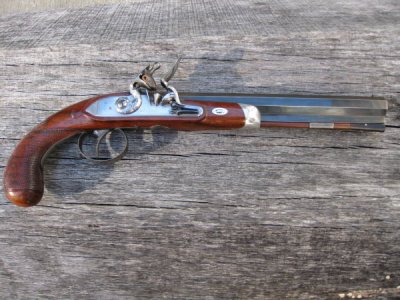
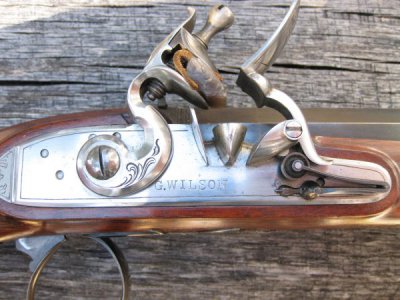
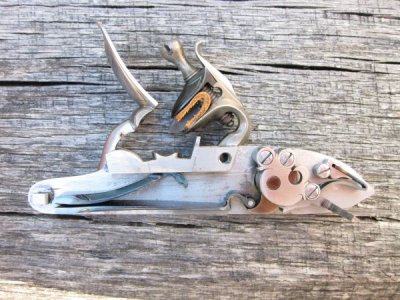
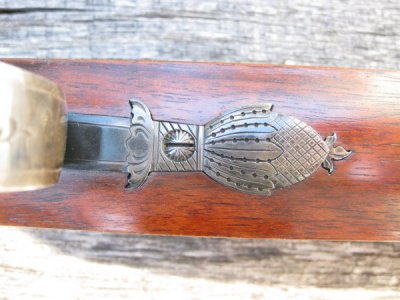
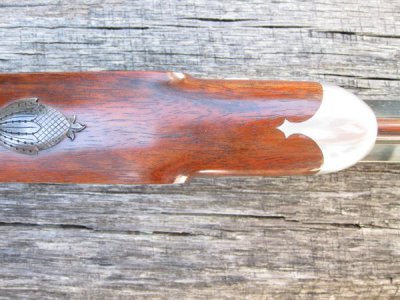
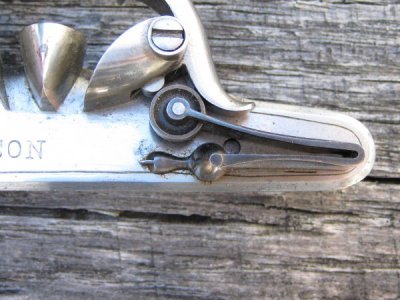
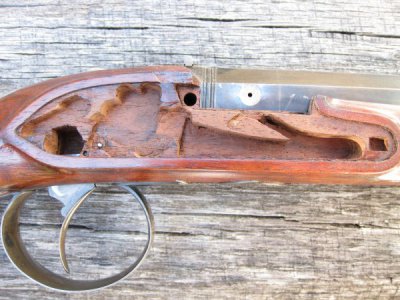
EVERY OTHER feature is identical to a dueling pistol.
Although dueling itself was illegal in England and America,duels were still held. You would be in even MORE trouble if you were caught using a rifled pistol. Besides,the challenged person got his choice of the 2 pistols. You could be challenged if you saw a man's wife"s ANKLE accidentally as she got into na carriage. It got ridiculous! Everything was done in the "Dueling code" to PREVENT you from hitting your opponent. Movies never seem to get it right. You would be instantly shot by the "Seconds" if you were seen to be SIGHTING your pistol. You raised your pistol in a smooth motion,and TRIED to fire it just as the pistol came on target. VERY difficult,especially with the delay of the lock time. If you killed your opponent,you'd better leave the country unless you were VERY important!
The only thing I did not do from scratch was rifle the barrel. I made the lock and its internal parts. The lock has all of the last improvements that were made to flintlocks before percussion guns came on the scene. It has a roller on the tip of the spring.This enabled the BATTERY(We call it the "frizzen",to spring open faster. A very fast lock was highly desirable. It is harder to hold a flintlock gun on target than a percussion because it just doesn't fire the gun as fast as a percussion cap. There is gunpowder in the "pan" under the frizzen. This has to light,and burn through a small hole to ignite the main charge. No matter what you do,this takes time,even if it is a split second. The pan itself is the so called "waterproof" type.(No one WAS waterproof!) It is cut away on both sides to allow the rain to flow around the pan,and the pan is VERY closely fitted as seamless as possible. A smear of wax would give you one shot most of the time.
The roller is positioned just right for the "toe" to trip over and flip open. Very important. The angle with which the flint is held is very important also. And,seldom gotten just right in repros.
The breech on this gun is a lot more complex than it looks. The barrel has all the latest improvements too. It tilts up once you tap out the oblong slide that secures it,and can be easily removed for cleaning with soapy water away from the wooden stock. The slide is surrounded on each side by silver ovals that are pinned to the stock.
Inside the breech there is a very tapered hole that gets small at the outside of the barrel,to prevent a lot of pressure loss from the main charge. The outside of the touch hole is gold lined to prevent corrosion making the hole larger. Opposite the touch hole on the other side of the barrel there is a cleanout screw to aid in cleaning.
The touch hole goes into a 1/4"(approx) "ante chamber". The powder in this chamber ignites and shoots a large,hot flame into the heart of the main charge. This was supposed to help in burning ALL of the powder.
Where the barrel breaks away from the breech tang,the joint is hidden under a small molding,so the barrel looks quite solid.
Inside the lock,the mainspring has a small,hardened steel roller that rolls smoothly against the tumbler,to smooth out and speed up the lock time again. Everything is hardened. Hardening is necessary for wear,but also helped against corrosion as it rusts less quickly than soft steel.
The stock has the shallow,broad topped 18th. C. style checkering. Today we use sharp topped checkering.
The trigger guard is spring steel. It is indeed "sprung" into the inletting it fits into,after the best English tradition of the time(and the present,too!) It cannot get loose or rattle about at all. It has to be compressed a bit to fit into the inletting in front of the handle. There it stays in a constant state of tension. Of course it is also secured with screws.
The stock is walnut. There is a silver "thumb piece",which had the owner's initials engraved on it. On the top of the barrel is a long rectangle of silver,inlaid into the steel,with my name,as the maker,on it.
The nose of the stock is pewter,which was poured directly into place by wrapping the gun securely with thick paper,holding it muzzle up,and pouring the pewter. The pewter did not even scorch the paper. The outer shape was then filed to shape. The pewter cast beautifully into the shapes carved into the stock to receive it. This was a common practice for a very long time.
This late period pistol had a concave steel rib under the barrel,to hold the ramrod. It has one ramrod "pipe" to snugly hold the ramrod,which is made of Brazilian rosewood with a black horn tip. This tapered ramrod was very carefully fitted so that it was snugly held when fully inserted into the pipe. This kept it from kicking loose. The pistol was usually actually loaded with a more substantial ramrod and mallet in actual use. But,tradition being in play,the pistol did retain the ramrod anyway.
The trigger guard terminates in the form of a pineapple,which was the symbol of hospitality in the 18th. C.. Coming from so far away,if you served your guests pineapple,they were getting very special(and very expensive) treatment. And,of course,you wanted to shoot your opponent in a hospitable manner!
Thin inletting of the lock,and ALL parts,was done as tightly as possible. this to show good workmanship,and to keep the stock as strong as possible against the kick.
A second mark of good craftsmanship,that is too often NOT seen,is that all the corners of the barrel,lock,etc.,must be SHARP,NOT rounded over IN THE LEAST.
The trigger guard's bow was engraved with the shield of Britannia,crossed cannon.,etc.. Too bad I did not take a picture if that. But,I did not have a good enough closeup camera at the time.
ENJOY!
All this work was hand filed and hand engraved. On a lock or trigger guard,with all the curves,there isn't much you can machine. It took months to build this pistol.







Last edited:

